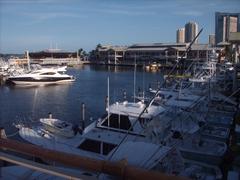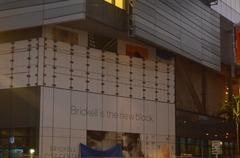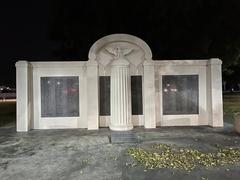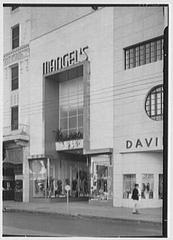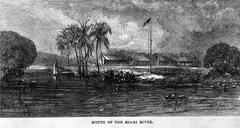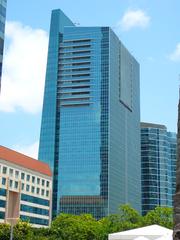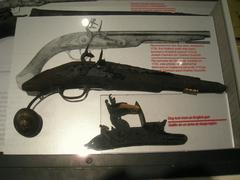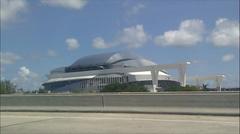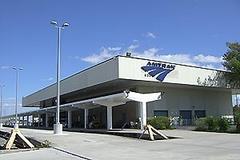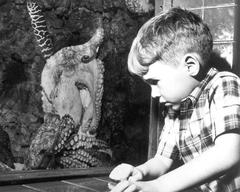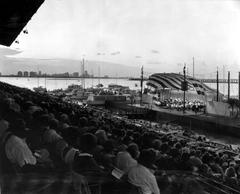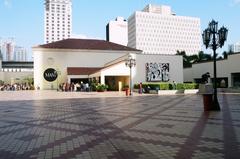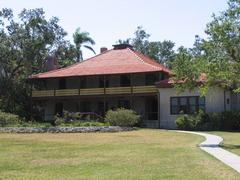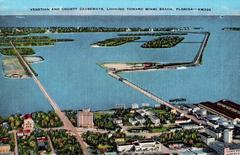
Miami Orange Bowl Visiting Hours, Tickets, and Historical Significance Guide
Date: 03/07/2025
Introduction
The Miami Orange Bowl stands as an iconic symbol in the history of American sports and Miami’s cultural landscape. Though the original stadium was demolished in 2008, its legendary past and ongoing influence continue to shape the city’s identity. From hosting championship football games and Super Bowls to serving as a community gathering point in Little Havana, the Orange Bowl’s legacy endures through commemorative displays at LoanDepot Park and the annual Orange Bowl Game at Hard Rock Stadium. This comprehensive guide explores the stadium’s origins, sporting and cultural significance, current visitor opportunities, ticketing, and tips for making the most of your Miami sports heritage experience. (Living New Deal; Orange Bowl Official; LoanDepot Park Official Site)
Table of Contents
- Introduction
- Origins and Construction
- Evolution and Expansion
- Sporting Legacy
- Cultural and Community Significance
- Decline, Demolition, and the Site Today
- Orange Bowl Game: Tickets, Visiting Hours, and Experience
- Miami Orange Bowl: Cultural Heritage & Economic Impact
- Visitor Guide: Practical Information and FAQs
- Summary and Call to Action
- References
Origins and Construction
Constructed during the Great Depression as a public works initiative, the stadium began as Burdine Stadium in 1936, named for local businessman Roddy Burdine. Funding was secured through the Public Works Administration, and the project was completed in December 1937 (Living New Deal). The first game was played by high school teams before the stadium’s official opening for the University of Miami Hurricanes. (Wikipedia; Everything Explained Today)
Evolution and Expansion
Over its 70-year history, the stadium expanded from modest beginnings to a capacity of over 72,000 seats, introducing innovations such as night lighting. In 1959, it was renamed the Miami Orange Bowl, reflecting its association with the annual college football game that would become a fixture of American sports (The Sun; Sportskeeda).
Sporting Legacy
College Football
The stadium was home to the Miami Hurricanes from 1937 to 2007, witnessing five national championships and the team’s legendary 58-game home winning streak (Wikipedia; Sportskeeda). The Orange Bowl Game, hosted here from 1938 to 1996, became an essential part of the college football postseason (Britannica).
Professional Football
The Miami Dolphins played at the Orange Bowl from 1966 to 1986, including their 1972 undefeated season and Dan Marino’s early career (Everything Explained Today; The Sun).
Super Bowls and Major Events
The stadium hosted five Super Bowls (II, III, V, X, XIII), including Super Bowl III’s famous upset. It also welcomed Olympic soccer, Gold Cup matches, concerts, and significant civic events such as President John F. Kennedy’s address to Cuban refugees (Sportskeeda; The Sun).
Baseball and Soccer
In addition to football, the Orange Bowl served variously as a minor league baseball venue and the home field for soccer teams like the Miami Gatos and Miami Toros (Wikipedia).
Cultural and Community Significance
Deeply embedded in Little Havana, the Orange Bowl was more than a sports venue; it was a cultural landmark, central to community identity and local traditions. The Orange Bowl Festival became a major event, featuring parades, tournaments, and community gatherings. The stadium’s proximity to the neighborhood meant residents were integral to the event experience, reflecting Miami’s multicultural vibrancy (Sportskeeda; Britannica; NY Times Athletic).
Decline, Demolition, and the Site Today
By the end of the 20th century, the Orange Bowl’s facilities became outdated. The Dolphins and the Orange Bowl Game moved to newer stadiums, and the Hurricanes played their final game at the Orange Bowl in 2007. The stadium was demolished in 2008 (Living New Deal).
Visiting the Site
The former stadium site is now occupied by LoanDepot Park, home of the Miami Marlins. Visitors can find commemorative tributes such as benches made from original stadium seats (The Sun).
Practical Information:
- Location: 501 Marlins Way (NW 16th Avenue), Miami, FL 33125
- Tour Hours: Stadium tours are typically available from 10:00 AM to 4:00 PM on non-game days. Confirm current schedules at the LoanDepot Park tours page.
- Accessibility: ADA-compliant facilities, with accessible seating, restrooms, and parking.
- Tickets: No ticket needed to visit the site; tour and game tickets sold separately (LoanDepot Park Official Site).
Nearby Attractions
Explore the heart of Little Havana—Calle Ocho, Domino Park, Cuban eateries, and the Cuban Memorial Boulevard. Downtown Miami and Vizcaya Museum and Gardens are also nearby (Vizcaya Museum and Gardens).
Guided Tours and Events
While there are no official Orange Bowl stadium tours, LoanDepot Park offers guided tours that incorporate the site’s rich history. Walking tours of Little Havana often include stories of the Orange Bowl.
Orange Bowl Game: Tickets, Visiting Hours, and Experience
Historical Overview
The Orange Bowl Game, established in 1935, is the second-oldest college football bowl game, originally intended to promote tourism and civic pride. It has played a pivotal role in shaping college football’s postseason and is now a part of the College Football Playoff rotation (Miami and Beaches; Orange Bowl Official).
The Venue and Modern Experience
Since 2008, the Orange Bowl Game has been held at Hard Rock Stadium in Miami Gardens. The stadium offers state-of-the-art amenities, ADA accessibility, and a festive, multicultural atmosphere (Stadium Wanderer).
Tickets and Scheduling
- Tickets: Purchase through the Orange Bowl Official website or authorized sellers. Early purchase is recommended.
- Visiting Hours: Fan Fest and other events occur throughout the day; check the official schedule for exact times (Miami and Beaches).
- Accessibility: Hard Rock Stadium provides ADA-compliant seating, parking, and services.
Game Day and Traditions
Game day features Fan Fest events, live music, culinary experiences, and a memorable halftime show. The Orange Bowl is known for its electric atmosphere and storied football history (Go Jiffy Jeff).
Miami Orange Bowl: Cultural Heritage & Economic Impact
Cultural Significance
The Orange Bowl not only celebrates college football excellence but also highlights Miami’s multicultural spirit through parades, community programs, and inclusive traditions (collegenetworth.com; linkedin.com; time.com).
Economic Contributions
The Orange Bowl is a major economic driver, generating over $260 million in new economic output and media exposure in recent years. It supports local jobs, draws tens of thousands of visitors, and boosts Miami’s global profile (communitynewspapers.com; rockportanalytics.com; orangebowl.org).
Philanthropy
Proceeds fund youth sports, education, and health programs throughout South Florida, reinforcing the Orange Bowl’s commitment to community development (orangebowl.org).
Visitor Guide: Practical Information and FAQs
Getting There
- LoanDepot Park: Accessible by car, Metrobus, and Metrorail. Parking is available; pre-book on game days.
- Hard Rock Stadium: Located 15 miles north of downtown Miami, accessible by major highways, Brightline rail (with shuttle), and rideshare (Itinerant Fan).
Tips
- Book tickets and accommodations early.
- Use public transportation or official shuttles to avoid parking congestion.
- Explore Little Havana and nearby historical sites for a well-rounded visit.
FAQs
Q: Can I visit the original Miami Orange Bowl stadium?
A: The original stadium was demolished in 2008. Visit LoanDepot Park for tributes and take walking tours of Little Havana.
Q: Where is the Orange Bowl Game held now?
A: At Hard Rock Stadium in Miami Gardens.
Q: How do I buy tickets?
A: For the Orange Bowl Game, visit the official website. For Marlins games or tours, see the LoanDepot Park site.
Q: Is the site accessible?
A: Yes, both LoanDepot Park and Hard Rock Stadium provide ADA-compliant facilities.
Q: What else can I do nearby?
A: Explore Calle Ocho, Domino Park, Vizcaya Museum and Gardens, and downtown Miami attractions.
Summary and Call to Action
Though the Miami Orange Bowl stadium no longer stands, its enduring spirit continues to shape Miami’s sports and cultural scene. From the annual Orange Bowl Game and commemorative tributes at LoanDepot Park to the lively streets of Little Havana, visitors can connect with a rich legacy of triumph, community, and celebration. Plan ahead—purchase tickets early, explore guided tours, and immerse yourself in Miami’s unique blend of history, culture, and sports. For the latest updates and exclusive content, follow official sources and download the Audiala app.
References
- Living New Deal, City of Miami Public Works Department
- Wikipedia, Miami Orange Bowl
- Everything Explained Today, Miami Orange Bowl
- The Sun, Orange Bowl Miami Demolished
- Sportskeeda, Miami Orange Bowl History
- Britannica, Orange Bowl
- NY Times Athletic, West End Zone Crew Reunite
- Miami and Beaches, Capital One Orange Bowl College Football Playoff Semifinals
- Orange Bowl Official, The Game
- Stadium Wanderer, LoanDepot Park Miami Marlins Guide
- Mundilimos, Capital One Orange Bowl
- Community Newspapers, Orange Bowl Generates Over $260 Million
- Rockport Analytics, Economic Drivers for South Florida
- Time, Orange Bowl History
- Liquisearch, Miami Orange Bowl Final Year and Demolition
- MLB.com, LoanDepot Park Official Site
- Itinerant Fan, Miami Sports Travel Guides
- Vizcaya Museum and Gardens, Official Website
Explore Miami’s storied past and vibrant present by visiting the Orange Bowl site, attending the annual game, and immersing yourself in local culture. Stay connected for the latest updates and event information.


















